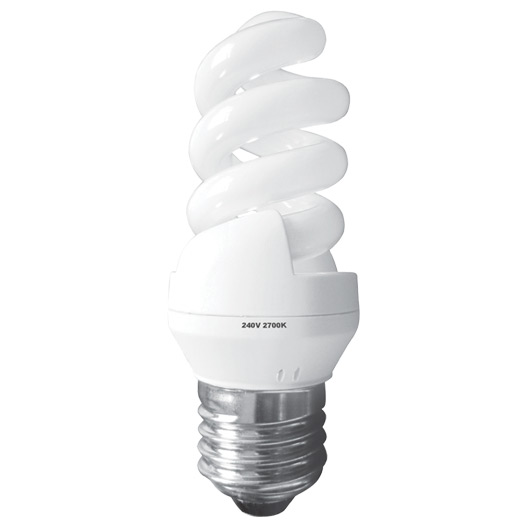The compact fluorescent lamp (CFL), or energy saving lamp, is now one of the most common household light bulbs used in the UK. Designed to replace traditional incandescent light bulbs, they are much more energy efficient and last longer. Whilst they can have the same lamp base as older light bulbs, their light output is expressed in Lumens, instead of Watts. Below is a guide to CFLs.
Lumens
The brightness of an incandescent light bulb has always been expressed in Watts (e.g. 40W, 60W, 100W etc.) but  Compact Fluorescent Lamps (CFLs), also known as energy saving lamps, use Lumens. A conventional incandescent bulb and a CFL light bulb may put out the same number of lumens, but the conventional bulb will consume three to five times the number of watts needed by the compact fluorescent. The table below shows the approximate relationship between the different bulb types in Watts and Lumens.
Compact Fluorescent Lamps (CFLs), also known as energy saving lamps, use Lumens. A conventional incandescent bulb and a CFL light bulb may put out the same number of lumens, but the conventional bulb will consume three to five times the number of watts needed by the compact fluorescent. The table below shows the approximate relationship between the different bulb types in Watts and Lumens.
Incandescent Bulb (W) |
Approx CFL Equivalent(W) |
Rated luminous flux (Lumen)* |
| 25W | 5W-7W | 229 Lumen |
| 40W | 7W-9W | 432 Lumen |
| 60W | 11W | 741 Lumen |
| 75W | 15W | 970 Lumen |
| 100W | 20W | 1398 Lumen |
*Values quoted are for guidance only and are the minimum CFL lumens required to claim equivalence between CFL and incandescent lamps.
Handling
Always handle a light bulb by its base rather than the glass and never forcefully twist it into the socket.
What To Do If A CFL Breaks
Fluorescent light bulbs contain very small amounts of mercury, sealed inside the glass tubing. The likelihood of a bulb breakage causing health problems is extremely low, but nonetheless steps should be taken to limit any exposure to mercury, as well as to the risk of cuts from glass fragments. In the event of a breakage:
- Clear the room of people and pets, ensuring they do not walk through the area of the breakage
- Turn off any air conditioning or ventilation system in the room.
- Open a window and leave the room for 15-20 minutes, ensuring all internal doors are closed.
- To clean up on hard surfaces, carefully scoop up glass pieces and powder using stiff paper or cardboard and place them in a glass jar with metal lid or in a sealed plastic bag. Use sticky tape, such as duct tape, to pick up any remaining small glass fragments and powder. Wipe the area clean with damp paper towels or disposable wet wipes, placing used towels in the glass jar or plastic bag. Do not use a vacuum or broom to clean up the broken bulb on hard surfaces.
- To clean up on carpet or rugs, carefully pick up glass fragments and place them in a glass jar with metal lid or in a sealed plastic bag. Use sticky tape, such as duct tape, to pick up any remaining small glass fragments and powder. If vacuuming is needed after all visible materials are removed, vacuum the area where the bulb was broken and then remove the vacuum bag (or empty and wipe the canister), and put the bag or vacuum debris in a sealed plastic bag.
- If clothing, bedding or other soft materials come into direct contact with broken glass or mercury-containing powder from inside the bulb that may stick to the fabric, the clothing or bedding should be thrown away. Do not wash such clothing or bedding because mercury fragments in the clothing may contaminate the machine and/or pollute sewage. You can wash clothing or other materials that have been exposed to mercury vapour, as long as it has not come into direct contact with the materials from the broken bulb. If shoes come into direct contact with broken glass or mercury-containing powder from the bulb, wipe them off with damp paper towels or disposable wet wipes. Place the towels or wipes in a glass jar or plastic bag for disposal.
- When disposing of clean-up materials, the bag or glass jar should NOT be disposed of in your household waste but at a civic amenity site or household waste recycling centre.
- Wash your hands after disposing of the jars or plastic bags containing clean-up materials
Disposal CFLs At The End Of Their Life
All broken or used fluorescent tubes and CFLs must be taken to designated collection facilities at local authority civic amenity sites, where they will be removed for treatment and recycling. See www.recycle-more.co.uk to search for your local facility for the disposal of CFL bulbs, or contact your local council directly.




